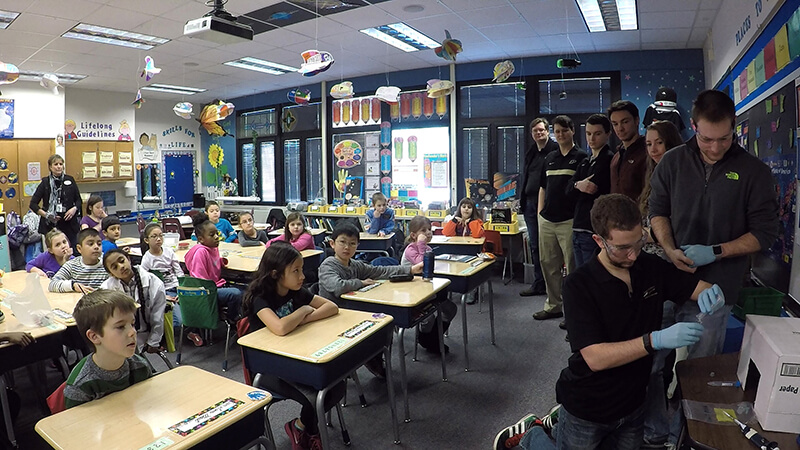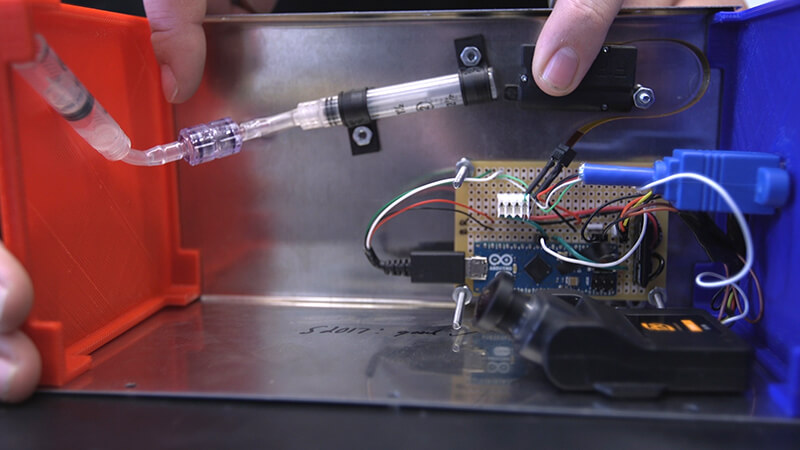May 4, 2017
Purdue project with West Lafayette students ready for lift-off

Purdue aeronautics engineering undergraduate students meet with Maggie Samudio’s second-grade class at Cumberland Elementary School. (Photo/College of Engineering)
WEST LAFAYETTE, Ind. — Purdue University students and West Lafayette second-graders alike are anxiously awaiting their mutual experiment to head up on a Blue Origin sub-orbital rocket.
For more than two years, College of Engineering students in the School of Astronautics and Aeronautics have helped Maggie Samudio’s second-grade students perfect an experiment testing whether the Say’s Firefly can glow in a zero-gravity environment.
Steven Collicott, Ph.D., an aeronautics and astronautics professor for the College of Engineering, said the rocket with the experiment – titled the Zero-Gravity Glow Experiment – will go up later this year. No exact launch date has been released.
Collicott said as many as 25 aerospace engineering students have helped the second-graders with the project, including interacting through classroom visits and demonstrations.
''It's been great fun working with my local grade school,” Collicott said. “I was pleasantly surprised with the intense interest of the students in all aspects of the experiment, from how high or fast the rocket goes to a question about if we will have enough dissolved oxygen in the chemical solutions for the glowing reaction to happen.”
Video of the experiment and the Purdue students working with second-graders is at https://youtu.be/rmTqmaaxIQw.
The rocket is expected to reach a peak altitude of 60 miles. Most airlines fly at a height of about seven miles up while the highest balloons will reach 20 miles up.
Collicott said the automated experiment weighs one pound and connects to the rocket's computer via a USB cable that supplies electrical power and a digital signal with news about how the flight is progressing.
A micro-computer listens to signals from the rocket. When weightlessness begins, the controller turns on a high-definition video camera and recorder as well as a device that pushes the plunger of a syringe.
 The Zero-Gravity Glow experiment is expected to launch on a Blue Origin sub-orbital rocket later this year. (Photo/College of Engineering)
Download image
The Zero-Gravity Glow experiment is expected to launch on a Blue Origin sub-orbital rocket later this year. (Photo/College of Engineering)
Download image
Collicott said the syringe injects one of the firefly chemicals into the other, causing the reaction to occur. The experiment recording will continue through descent and landing.
“I want to stress that we are seeking to lead the way,” he said. “This exact launch opportunity is available to all schools in the years ahead.”
Collicott is no stranger to the Blue Origin rocket launches. He was one of three scientists asked by Blue Origin to work with the private company as it tested and perfected its suborbital rocket design.
An experiment by Collicott testing the physics of liquid movement in zero-gravity situations was carried in the payload of rocket which took off on June 19 from a private location in Texas.
Writer: Brian L. Huchel, 765-494-2084, bhuchel@purdue.edu
Source: Steven Collicott, 765-494-2339, collicott@purdue.edu
